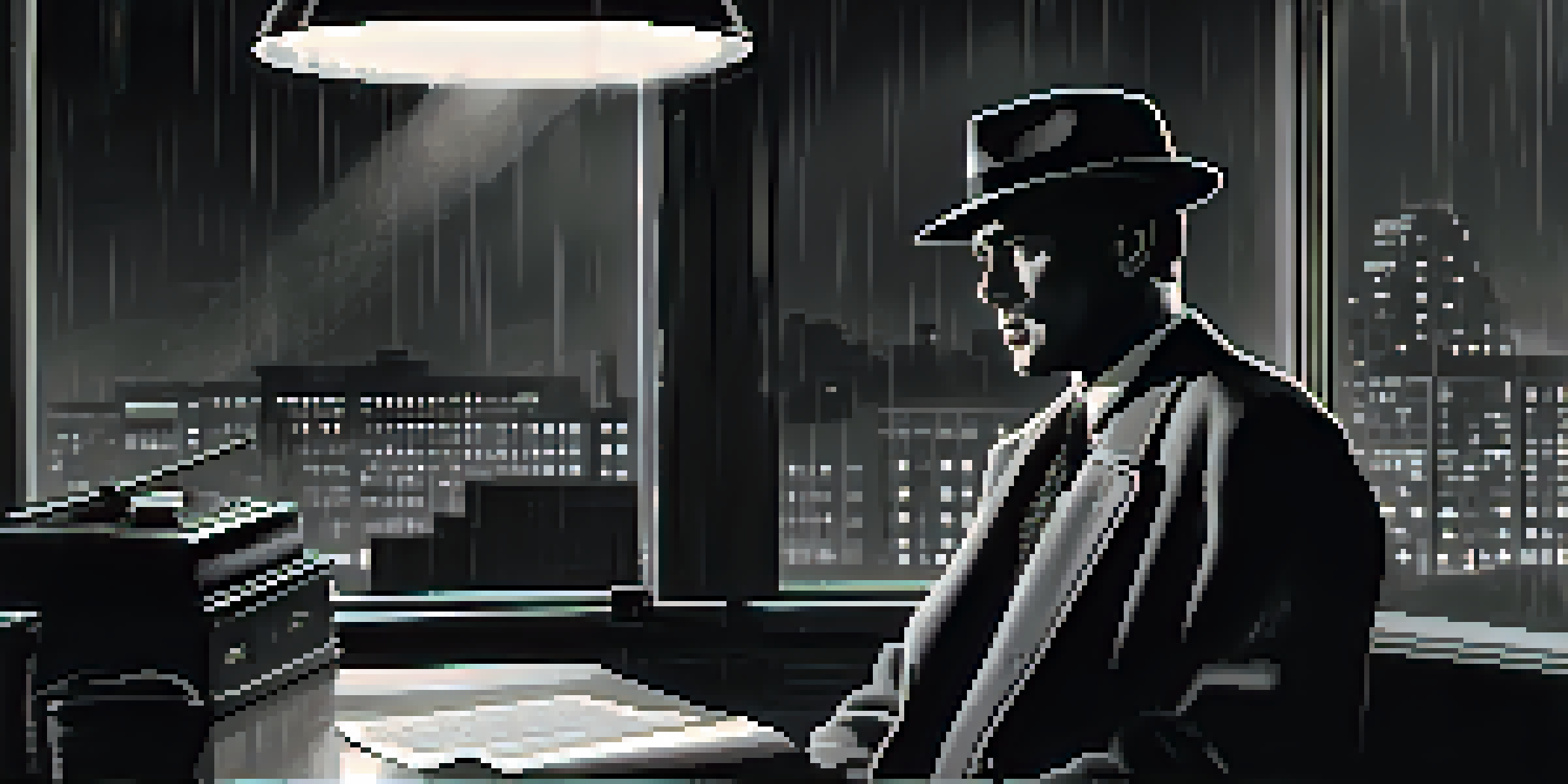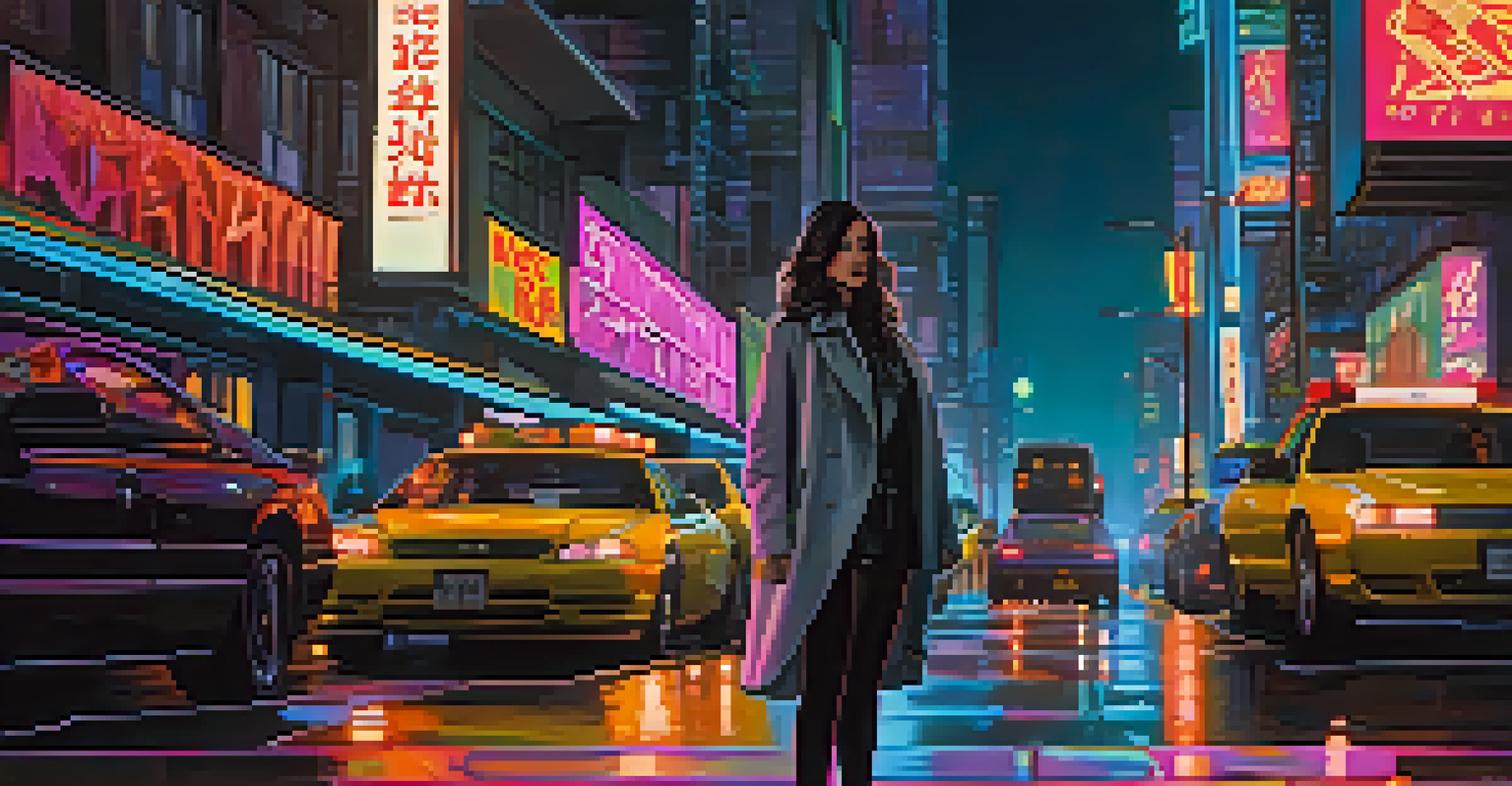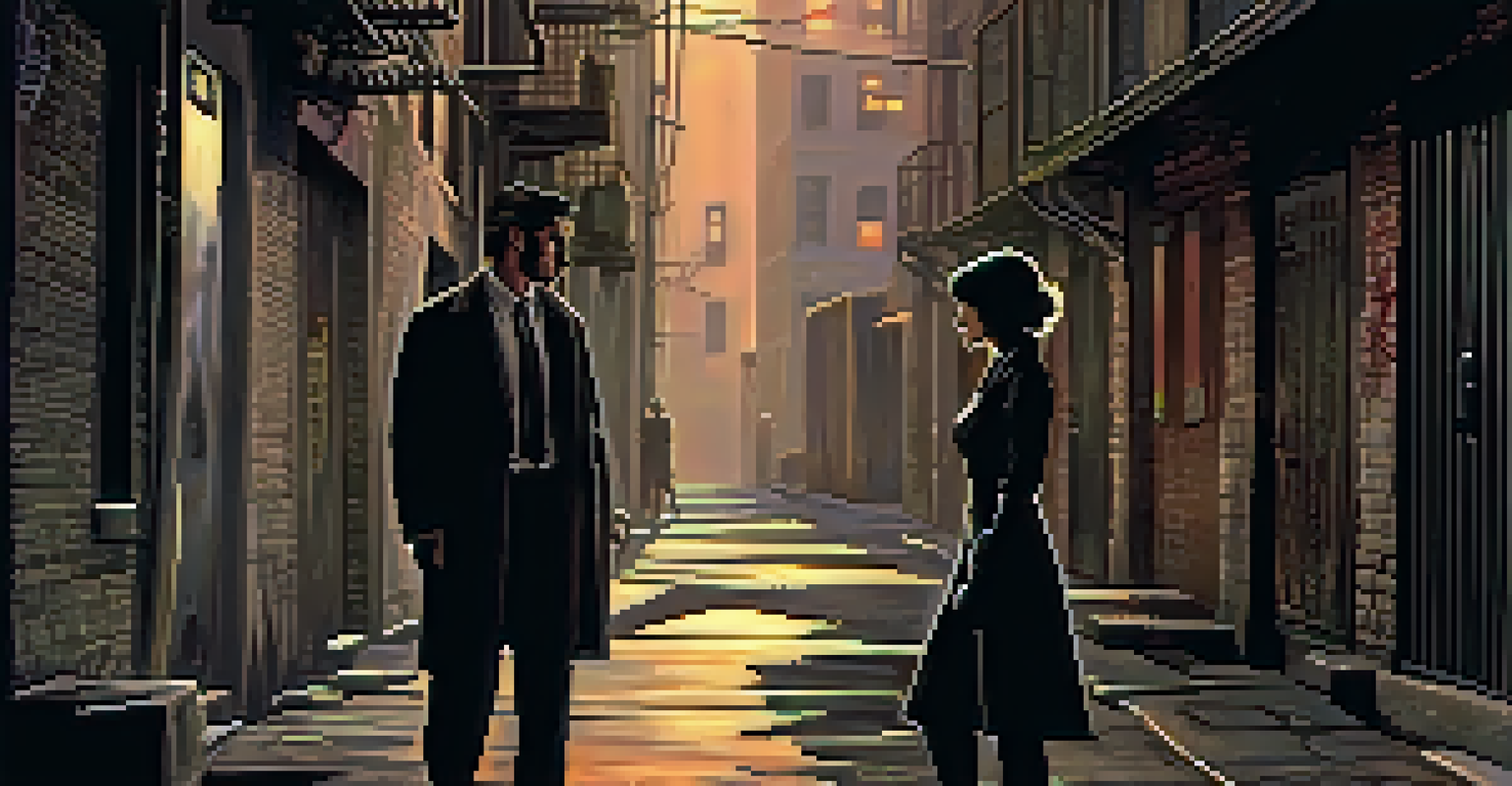Film Noir's Evolution: From Classic to Neo-Noir Cinemas

The Origins of Classic Film Noir in the 1940s
Film Noir emerged in the early 1940s, a product of gritty post-war America. This genre was characterized by its moody visuals, cynical attitudes, and complex narratives. It was heavily influenced by German Expressionism, which brought a unique aesthetic that emphasized shadows and stark contrasts.
Film noir is a style that is very much concerned with the human condition, and the moral ambiguities of life.
Classic Film Noir often featured hard-boiled detectives and femme fatales, creating a sense of moral ambiguity that captivated audiences. Movies like 'Double Indemnity' and 'The Maltese Falcon' set the standard for the genre, showcasing intricate plots and morally complex characters. These films not only entertained but also reflected the anxieties of the time.
As World War II ended, filmmakers used Noir to explore themes of disillusionment and existential dread. This blend of crime and psychological depth allowed audiences to connect with the characters' struggles, making the genre not just a visual experience but an emotional one.
Key Characteristics of Classic Film Noir
Classic Film Noir is easily recognized by its stylistic elements and narrative techniques. The use of low-key lighting creates a sense of suspense and unease, drawing viewers into the story's darker aspects. Additionally, the fragmented storytelling often mirrors the characters’ fractured psyches, enhancing the theme of moral ambiguity.

Another hallmark of this genre is its iconic character archetypes, particularly the femme fatale. These complex women often manipulate men, challenging traditional gender roles and adding depth to the plot. The protagonists, usually flawed anti-heroes, navigate a world rife with betrayal and deceit, making every decision fraught with tension.
Film Noir's Gritty Origins
Emerging in the 1940s, Film Noir reflected post-war America's anxieties through its moody visuals and complex narratives.
The dialogue in these films is sharp and witty, filled with clever repartee that keeps audiences engaged. This blend of visual style and gripping storytelling solidified Film Noir's place in cinematic history, influencing countless filmmakers and genres that followed.
The Transition: From Classic Noir to Neo-Noir
As the 1960s approached, Film Noir began evolving into what we now refer to as Neo-Noir. This new wave retained the stylistic and thematic elements of its predecessor but introduced contemporary issues and more diverse storytelling. The shift reflected changes in society, where cultural revolutions were reshaping narratives and character development.
Noir is not a genre, it’s a style, a way of seeing the world.
Neo-Noir films often incorporate modern technology and urban settings, reflecting the complexities of life in a rapidly changing world. Movies like 'Chinatown' and 'Blade Runner' illustrate how the genre adapted to new societal concerns, including corruption, environmental issues, and the nature of reality itself. This evolution allowed filmmakers to push boundaries while retaining the essence of Noir.
Furthermore, Neo-Noir often embraces a wider range of characters and perspectives, including those from marginalized communities. This shift not only diversified the storytelling but also enriched the genre, allowing for deeper explorations of themes such as identity and existential despair.
Notable Neo-Noir Films and Their Impact
Several standout films define the Neo-Noir movement and showcase its evolution. For instance, 'Se7en' delves into the psychological aspects of crime while challenging the traditional noir formula. The film's bleak atmosphere and complex characters illustrate the darker side of human nature, echoing classic Noir themes in a contemporary context.
Another significant entry is 'The Big Lebowski,' which blends elements of comedy with noir conventions. By subverting traditional tropes, the Coen brothers created a film that pays homage to its predecessors while carving out its own unique identity. This playful approach has inspired a new generation of filmmakers to experiment with Noir elements in innovative ways.
Evolution to Neo-Noir
As society changed in the 1960s, Neo-Noir adapted classic elements while addressing contemporary issues and diverse storytelling.
These films underscore how Neo-Noir has not only preserved the spirit of classic Film Noir but also expanded its boundaries. As audiences continue to seek fresh narratives and perspectives, the genre remains a vital part of cinematic storytelling.
Themes of Alienation and Morality in Neo-Noir
A key theme in both classic and Neo-Noir films is the exploration of alienation and moral ambiguity. Characters often find themselves isolated in a world filled with betrayal, reflecting the disconnection many people feel in modern society. This theme resonates strongly with audiences, as it mirrors real-life struggles with trust and personal integrity.
In Neo-Noir, the exploration of morality is often more nuanced, presenting characters who operate in shades of gray rather than clear-cut good versus evil. Films like 'Memento' and 'Fight Club' challenge viewers to question their perceptions of right and wrong, engaging them in a deeper philosophical discourse. This complexity enriches the narrative, inviting viewers to reflect on their own values.
Moreover, the portrayal of urban settings in Neo-Noir emphasizes feelings of disconnection and anonymity. The characters navigate sprawling cities that serve as both a backdrop and a character in their own right, further highlighting their struggles. This sense of place enhances the mood and reinforces the overarching themes of alienation and moral uncertainty.
The Role of Women in Film Noir Evolution
The representation of women has transformed significantly from classic Film Noir to Neo-Noir. In the early days, femme fatales were both alluring and dangerous, often depicted as manipulative figures. While these characters added depth to the narrative, they also reinforced certain stereotypes about women in cinema, creating a complex legacy.
In contrast, Neo-Noir has seen the emergence of more multi-dimensional female characters who defy traditional roles. Films like 'The Brave One' and 'Gone Girl' showcase women who are not only strong but also deeply flawed, reflecting the complexities of real-life female experiences. This evolution in character portrayal invites a broader exploration of gender dynamics within the genre.
Future Trends in Film Noir
With advancements in technology and global cinema, Film Noir continues to evolve, exploring timeless themes in innovative ways.
Furthermore, the rise of female filmmakers in Neo-Noir has brought fresh perspectives and narratives to the forefront. Directors like Kathryn Bigelow and Greta Gerwig are reshaping the genre, creating stories that challenge established norms and highlight diverse experiences. This shift signifies not just a change in portrayal but a significant cultural moment within the cinema landscape.
The Future of Film Noir: Trends and Innovations
As we look to the future, Film Noir continues to adapt and thrive in an ever-changing cinematic landscape. New technologies, such as streaming platforms and virtual reality, offer innovative ways to tell noir stories, reaching wider audiences than ever before. These advancements not only enhance the viewing experience but also provide filmmakers with new tools for creativity.
Moreover, the rise of global cinema is introducing diverse interpretations of Noir, expanding its reach beyond Hollywood. International filmmakers are incorporating local cultural elements into the genre, resulting in unique narratives that resonate with various audiences. This globalization enriches the Film Noir tradition, allowing it to evolve across different contexts and cultures.

Ultimately, the future of Film Noir holds endless possibilities as it continues to explore timeless themes of morality, identity, and societal issues. With each new wave of storytellers, the genre remains relevant, captivating audiences and inviting them to ponder the complexities of the human experience.